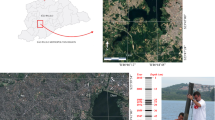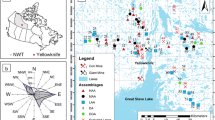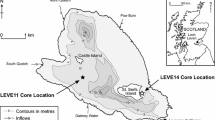Abstract
Arcellacea (testate lobose amoebae) were examined in 24 sediment–water interface samples collected over two late August field seasons in 2010 and 2011, from James and Granite lakes, Temagami Region, Northeastern Ontario. The work was carried out to quantitatively test species–environment relationships in a lake system known to be characterized by a significant pH gradient, partially the result of contamination from the early twentieth century Northland Pyrite Mine Co., located on the shoreline in the southern basin of James Lake. Redundancy analysis confirmed that arcellacean assemblage structure was most strongly controlled by pH, explaining 14.06 % (p < 0.002) of the total variance. Q- and R-mode cluster analysis supported by detrended correspondence analysis yielded two major faunal assemblages. The Oligotrophic Assemblage (1) had a Shannon Diversity Index (SDI) ranging up to 2.45, typical of healthy boreal lakes. This assemblage characterized samples collected from higher pH stations within James and Granite lakes away from the immediate area of the mine site, while the Low pH Assemblage 2010 (2a) and Low pH Assemblage 2011 (2b) groupings were from the very low pH environments of James Lake adjacent to the former mine site. Both low diversity assemblages (SDI ranging from 0.62 to 1.22) were characterized by Arcella vulgaris, a species known to thrive in hostile lacustrine environments. Differing depositional conditions during August 2010, a probable result of different prevailing wind patterns that summer, led to allochthonous specimens of the seasonally planktic Cucurbitella tricuspis dominating the Low pH Assemblage 2010 (2a) fauna.






Similar content being viewed by others
References
Patterson RT, Kumar A (2002) A review of current testate rhizopod (thecamoebian) research in Canada. Palaeogeogr Palaeocl Palaeoecol 180:225–251
Mitchell EAD, Charman DJ, Warner BG (2008) Testate amoebae analysis in ecological and paleoecological studies of wetlands: past, present and future. Biodivers Conserv 17:2115–2137
Medioli FS, Scott DB (1988) Lacustrine thecamoebians (mainly arcellaceans) as potential tools for palaeolimnological interpretations. Palaeogeogr Palaeocl Palaeoecol 62:361–386
Neville LA, McCarthy FMG, MacKinnon MD (2010) Seasonal environmental and chemical impact on thecamoebian community composition in an oil sands reclamation wetland in Northern Alberta. Palaeontol Electron 13.2.13A:14
Neville LA, McCarthy FMG, MacKinnon MD, Swindles GT, Marlowe P (2011) Thecamoebians (testate amoebae) as proxies of ecosystem health and reclamation success in constructed wetlands in the oil sands of Alberta, Canada. J Foramin Res 41:230–247
Patterson RT, Kumar A (2000) Assessment of arcellacean (thecamoebian) assemblages, species, and strains as contaminant indicators in James Lake, Northeastern Ontario, Canada. J Foramin Res 30:310–320
Wall A, Gilbert D, Magny M, Mitchell E (2010) Testate amoebae analysis of lake sediments: impact of filter size and total count on estimates of density, species richness and assemblage structure. J Paleolimnol 43:689–704
Wall AAJ, Magny M, Mitchell EAD, Vannière B, Gilbert D (2010) Response of testate amoeba assemblages to environmental and climatic changes during the Lateglacial–Holocene transition at Lake Lautrey (Jura Mountains, eastern France). J Quat Sci 25:945–956
Telford RJ, Birks HJB (2011) Is spacial correlation introducing biases in the apparent accuracy of paleoclimatic reconstructions? A rejoinder. Quaternary Sci Rev 30:3210–3213
Patterson RT, Roe HM, Swindles GT (2012) Development of an Arcellacea (testate lobose amoebae) based transfer function for sedimentary phosphorous in lakes. Palaeogeogr Palaeocl Palaeoecol. doi:10.1016/j.palaeo.2012.05.028
Roe HM, Patterson RT, Swindles GT (2010) Controls on the contemporary distribution of lake thecamoebians (testate amoebae) within the Greater Toronto area and their potential as water quality indicators. J Paleolimnol 43:955–975
Farooqui A, Kumar A, Swindles GT (2012) Thecamoebian communities as proxies of seasonality in Lake Sadatal in the Ganga-Yamuna Plains of North India. Palaeontol Electron 15.1.3A:19
Riveiros NAV, Babalola AO, Boudreau REA, Patterson RT, Roe HM, Doherty C (2007) Modern distribution of salt marsh foraminifera and thecamoebians in the Seymour-Belize Inlet Complex, British Columbia, Canada. Mar Geol 242:39–63
Kauppila T (2006) Sediment-based study of the effects of decreasing mine water pollution on a heavily modified, nutrient enriched lake. J Paleolimnol 35:25–38
Kihlman S, Kaupila T (2009) Mine water-induced gradients in sediment metals and arcellacean assemblages in a boreal freshwater bay (Petkellajti, Finland). J Paleolimnol 42:533–550
Kihlman S, Kaupila T (2010) Tracking the aquatic impacts of a historical metal mine using lacustrine protists and diatom algae. Mine Water Environ 29:116–134
Kihlman S, Kaupila T (2012) Effects of mining on testate amoebae in a Finnish lake. J Paleolimnol 47:1–15
Escobar J, Brenner M, Whitmore TJ, Kenney WF, Curtis JH (2008) Ecology of testate amoebae (thecamoebians) in subtropical Florida lakes. J Paleolimnol 40:715–731
Patterson RT, Barker T, Burbidge SM (1996) Arcellaceans (thecamoebians) as proxies of arsenic and mercury contamination in northeastern Ontario lakes. J Foramin Res 26:172–183
Reinhardt EG, Dalby A, Kumar A, Patterson RT (1998) Utility of arcellacean morphotypic variants as pollution indicators in mine tailing contaminated lakes near Cobalt, Ontario, Canada. Micropaleontol 44:131–148
Kumar A, Patterson RT (2000) Arcellaceans (thecamoebians): new tools for monitoring long- and short-term changes in lake bottom acidity. Environ Geol 39:689–697
Patterson RT, Kumar A (2000) Use of arcellacea to gauge levels of pollution and remediation of industrially polluted lakes. In: Martin RE (ed) Environmental micropaleontology, vol 15, of topics in geobiology. Kluwer Academic/Plenum, New York, pp 257–278
Boudreau REA, Galloway JM, Patterson RT, Kumar A, Michel FA (2005) A paleolimnological record of Holocene climate and environmental change in the Temagami Region, northeastern Ontario. J Paleolimnol 33:445–461
Ontario Ministry of the Environment (2002) Safe Drinking Water Act. Available at http://www.ene.gov.on.ca/environment/en/legislation/safe_drinking_water_act/index.htm
Scott DB, Hermelin JOR (1993) A device for precision splitting of micropaleontological samples in liquid suspension. J Paleontol 67:151–154
Szava-Kovats R (2009) Re-analysis of the relationship between organic carbon and loss-on-ignition in soil. Comm Soil Sci Plant Anal 40:2712–2724
EPA (2011) SW-846 Online: Test Methods for Evaluating Solid Waste, Physical/Chemical Methods. US EPA. Available at http://www.epa.gov/osw/hazard/testmethods/sw846
Olsen SR, Cole CV, Watanabe FS, Dean LA (1954) Estimation of available phosphorous in soils by extraction with sodium bicarbonate. US Dept Agric Circ 939, Washington
Zhou Q, Gibson CE, Zhu Y (2001) Evaluation of phosphorus bioavaiability in sediments of three contrasting lakes in China and the UK. Chemosphere 42:221–225
Watanabe FS, Olsen SR (1965) Test of an ascorbic acid method for determining phosphorous in water and NaHCO3 extracts from soil. Soil Sci Soc Am Proc 29:677–678
Loeblich AR Jr, Tappan H (1964) Sarcodina, chiefly “Thecamoebians” and Foraminiferida. In: Moore RC (ed) Treatise on invertebrate paleontology, Part C, Protista 2. Geological Society of America and University of Kansas Press, Lawrence, pp 1–900
International Commission on Zoological Nomenclature (1999) International code of zoological nomenclature, 4th edn. The Natural History Museum, London, p 338
Kumar A, Dalby PB (1998) Identification key for Holocene lacustrine arcellacean (thecamoebian) taxa. Palaeontol Electron 1.1:34
Medioli FS, Scott DB (1983) Holocene arcellacea (thecamoebians) from Eastern Canada. Cushman Foundation for Foraminiferal Research, Washington, p 63, Special publication 21
Medioli FS, Scott DB, Abbott BH (1987) A case study of protozoan intraclonal variability: taxonomic implications. J Foramin Res 1:28–47
Asioli A, Medioli FS, Patterson RT (1996) Thecamoebians as a tool for reconstruction of paleoenvironments in some Italian lakes in the foothills of the southern Alps (Orta, Varese and Candia). J Foramin Res 26:248–263
Roe HM, Patterson RT (2006) Distribution of thecamoebians (testate amoebae) in small lakes and ponds, Barbados, West Indies. J Foramin Res 36:116–134
Patterson RT, Fishbein E (1989) Re-examination of the statistical methods used to determine the number of point counts needed for micropaleontological quantitative research. J Paleo 63:245–248
Shannon CE (1948) A mathematical theory of communication. AT&T Tech J 27(379–423):623–656
Magurran AE (1988) Ecological diversity and its measurement. Princeton University Press, Princeton, p 185
Fishbein E, Patterson RT (1993) Error weighted maximum likelihood (EWML): a new statistically valid method to cluster quantitative micropaleontological data. J Paleo 67:475–486
Jongman RHG, ter Braak CJF, van Tongeren OFR (eds) (1987) Data analysis in community and landscape ecology. Pudoc, Wageningen, p 301
Šmilauer P (1992) CanoDraw 3.0 users guide, environmental change research centre. University College, London
ter Braak CJF (2002) CANOCO for Windows version 4.51. Biometris-Plant Research International, Wageningen
Legendre P, Gallagher ED (2001) Ecologically meaningful transformations for ordination of species data. Oecol 129:271–280
Rao CR (1995) The use of Hellinger Distance in graphical displays of contingency table data. In: Tiit E-M, Kollo T, Niemi H (eds) New trends in probability and statistics, vol 3, Multivariate statistics and matrices in statistics. Brill, Leiden, pp 143–161
Birks HJB (1995) Quantitative palaenvironmental reconstruction. In: Maddy D, Brew JS (eds) Statistical modelling of quaternary science data. Quat Res Assoc, London, pp 161–251
Patterson RT, MacKinnon KD, Scott DB, Medioli FS (1985) Arcellaceans (thecamoebians) in small lakes of New Brunswick and Nova Scotia: modern distribution and Holocene stratigraphic changes. J Foramin Res 26:14–137
Schönborn W (1984) Studies on remains of Testacea in cores of the Great Woryty Lake (N.E. Poland). Limnologica 16:185–190
Correll DL (1999) Phosphorus: a rate limiting nutrient in surface waters. Poultry Sci 78:674–682
Conley DJ, Schelske CL (2001) Biogenic silica. In: Smol JP, Birks HJB, Last WM (eds) Tracking environmental change using lake sediments. v. 3: terrestrial, algal, and siliceous indicators. Kluwer Academic, Dordrecht, pp 281–293
Batterbee RW, Carvalho L, Juggins S (2001) Diatoms. In: Smol JP, Birks HJB, Last WM (eds) Tracking environmental change using lake sediments. v. 3: terrestrial, algal, and siliceous indicators. Kluwer Academic, Dordrecht, pp 155–202
Conley DJ (1988) Biogenic silica as an estimate of siliceous microfossil abundance in Great Lakes sediments. Biogeochemistry 6:161–179
Hurley JP, Armstrong DE, Kenoyer GJ, Bowser CJ (1985) Groundwater as a silica source for diatom production in a precipitation-dominated lake. Science 227:1576–1578
Levy DB, Barbarick KA, Siemer EG, Sommers LE (1992) Distribution and partitioning of trace metals in contaminated soils near Leadville, Colorado. J Environ Qual 21:185–195
Miao S, DeLaune RD, Jugsujinda A (2006) Influence of sediment redox conditions on release/solubility of metals and nutrients in a Louisiana Mississippi River deltaic plain freshwater lake. Sci Total Environ 371:334–343
Morford JL, Emerson S (1999) The geochemistry of redox sensitive trace metals in sediments. Geochim Cosmochim Acta 63:1735–1750
Ehrenberg CG (1832) Über die Entwicklung und Lebensdauer der Infusionstiere, nebst ferneren Beiträgen zu einer Vergleichung ihrer organischen Systeme. Abh Akad Wiss Berlin 1831:1–154
Carter HJ (1856) Notes on the freshwater Infusoria of the island of Bombay. Ann Mag Nat Hist 18(104):115–132
Penard E (1902) Faune Rhizopodique du bassin du lèman. Henry Kündig, Libraire de L’institut, Genève, p 712
Ehrenberg CG (1843) Verbreitung und Einfluss des mikroskopischen Lebens in Süd-und Nord Amerika. Königl Preufs Akad Wiss, Berlin, p 181
Ehrenberg CG (1830) Organisation, systematik und geographisches Verhältnis der Infusionstierchen. Königl Akad Wiss, Berlin
Deflandre G (1929) Le genre Centropyxis Stein. Arch Protistenkd 67:323–375
Leidy J (1874) Notice of some fresh-water and terrestrial rhizopods. P Acad Nat Sci Phila 26:86–88
Carter HJ (1864) On freshwater Rhizopoda of England and India. Ann Mag Nat Hist 13:18–39, ser 3
Wallich GC (1864) On the process of mineral deposit in the rhizopods and sponges, as affording a distinctive character. Ann Mag Nat Hist Ser 3(13):72–82
Ehrenberg CG (1840) Das grössere Infusorienwerke. Abh Akad Wiss, Berlin, pp 198–219
Patterson RT, Dalby A, Kumar A, Henderson LA, Boudreau EA (2002) Arcellaceans (thecamoebians) as indicators of land-use change: settlement history of the Swan Lake area, Ontario as a case study. J Paleolimnol 28:297–316
Smilauer P, ter Braak CJF (2002) CANOCO reference manual and canadraw for windows user`s guide: software for canonical community ordination (version 4.5). Micro-computer Power, Ithaca, p 500
Acknowledgments
This research was supported by a NSERC Discovery Grant to RTP. We thank the Carleton University Institute of Environmental Science for field support, Carley Crann for cartographic support, Graeme Swindles for assistance with the statistical analysis, Jianqun Wang for SEM photography and three anonymous reviewers for their constructive comments.
Author information
Authors and Affiliations
Corresponding author
Electronic supplementary material
Below is the link to the electronic supplementary material.
Supplementary Figure 1
Annotated aerial photograph of James and Granite lakes. Inset is a close-up of the Northland Pyrite Mine Co. site. Source Google Earth. Retrieved July 3, 2012. (JPEG 1949 kb)
Supplementary Table 1
Arcellacean species and strain occurrences in sediment–water interface samples from James and Granite lakes. Samples were quantitatively analyzed and are recorded as total counts and fractional abundances, together with the standard error associated with each value. The assemblage designation, Shannon Diversity Index (SDI), and water property values (water depth, pH, water temperature, O2 concentration) are also included for each sample. (DOCX 65 kb)
Rights and permissions
About this article
Cite this article
Patterson, R.T., Lamoureux, E.D.R., Neville, L.A. et al. Arcellacea (Testate Lobose Amoebae) as pH Indicators in a Pyrite Mine-Acidified Lake, Northeastern Ontario, Canada. Microb Ecol 65, 541–554 (2013). https://doi.org/10.1007/s00248-012-0108-9
Received:
Accepted:
Published:
Issue Date:
DOI: https://doi.org/10.1007/s00248-012-0108-9




